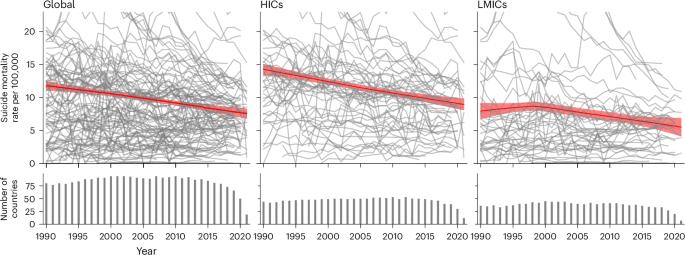Global, regional and national trends in suicide mortality rates across 102 countries from 1990 to 2021 with projections up to 2050
IF 8.7
引用次数: 0
Abstract
Global trends and future projections of suicide mortality are crucial to providing policy decision-makers with insights into estimating the global and future burden of suicide; however, they require techniques accounting for the effects of age, period and cohort on trends in suicide mortality and considering various factors such as population growth and aging. Therefore, we aimed to estimate the global trends in suicide mortality rates from 1990 to 2021 and the future projection of suicide deaths until 2050 across 102 countries. Global trends were calculated using a locally weighted scatter-plot smoother (LOESS) curve, and the association between the rates and socioeconomic and geographical indicators was investigated. The study also projected future suicide mortality rates up to 2050 using the Bayesian age–period–cohort model. In addition, a decomposition analysis was performed to identify the variations in suicide deaths, specifically examining factors such as population growth, aging and epidemiological changes. Of the 102 countries included in the analysis of suicide mortality, 54 were high-income countries (HICs) and 48 were low- and middle-income countries (LMICs). The LOESS estimate of the global suicide mortality rate decreased from 10.33 (95% confidence interval, 9.67–10.99) deaths per 100,000 people in 1990 to 7.24 (6.58–7.90) deaths per 100,000 people in 2021. Notably, overall global suicide mortality rates were higher among males compared with females, with males showing a decline from 16.41 (15.23–17.58) in 1990 to 11.51 (10.33–12.68) in 2021, and females from 4.65 (4.41–4.89) in 1990 to 3.22 (2.98–3.46) in 2021. In addition, HICs also had higher suicide mortality rates, from 12.68 (11.96–13.40) in 1990 to 8.61 (7.89–9.33) in 2021, compared with LMICs, which showed 7.88 (6.93–8.84) in 1990 and 5.73 (4.77–6.69) in 2021. We also identified an association between the age-standardized suicide rates and several parameters, including the Human Development Index (β, 24.250; P = 0.001), Sociodemographic Index (β, 0.091; P < 0.001), reverse Gender Gap Index (β, −39.913; P = 0.002), Gender Inequality Index (β, 13.229; P = 0.016) and latitude (β, 23.732; P < 0.001). The future predicted number of global suicide deaths up to 2050 would slightly decrease from 8.60 (95% credible interval, 8.40–8.83) deaths in 2021 to 8.42 (6.60–10.61) in 2030, 7.39 (4.25–13.17) in 2040 and 6.49 (2.19–17.57) in 2050. Although population growth and aging had contributed to an increase in the number of deaths, the overall count in 2021 had decreased compared with 1990, primarily due to the decline in the age-standardized suicide mortality rates. A global trend for a decrease in suicide mortality rate was observed from 1990 to 2021. Reflecting the overall decline, future suicide deaths are forecasted to decrease up to 2050 at the global level, with certain groups and countries remaining more vulnerable to suicide deaths. Therefore, these findings suggest the need for more effective strategies and policies to reduce suicide mortality. This study estimates global suicide mortality trends from 1990 to 2021 and projects future rates until 2050 using a locally weighted scatter-plot smoother and Bayesian age–period–cohort models, revealing substantial declines and highlighting socioeconomic factors influencing variations across high- and low-income countries.

1990年至2021年102个国家的全球、区域和国家自杀死亡率趋势,并预测到2050年
自杀死亡率的全球趋势和未来预测对于向政策决策者提供估计全球和未来自杀负担的见解至关重要;然而,他们需要考虑年龄,时期和队列对自杀死亡率趋势的影响的技术,并考虑人口增长和老龄化等各种因素。因此,我们的目的是估计1990年至2021年全球自杀死亡率的趋势,以及102个国家到2050年自杀死亡率的未来预测。利用局部加权散点图平滑曲线计算全球趋势,并研究速率与社会经济和地理指标之间的关系。该研究还使用贝叶斯年龄-时期-队列模型预测了到2050年的未来自杀死亡率。此外,还进行了分解分析,以确定自杀死亡的变化,具体考察了人口增长、老龄化和流行病学变化等因素。在参与自杀死亡率分析的102个国家中,54个是高收入国家,48个是低收入和中等收入国家。黄土估计的全球自杀死亡率从1990年的每10万人10.33例(95%置信区间,9.67-10.99)下降到2021年的每10万人7.24例(6.58-7.90)。值得注意的是,全球男性总体自杀死亡率高于女性,男性从1990年的16.41(15.23-17.58)下降到2021年的11.51(10.33-12.68),女性从1990年的4.65(4.41-4.89)下降到2021年的3.22(2.98-3.46)。此外,高收入人群的自杀死亡率也高于中低收入人群,从1990年的12.68(11.96-13.40)升至2021年的8.61(7.89-9.33),而中低收入人群的自杀死亡率分别为1990年的7.88(6.93-8.84)和2021年的5.73(4.77-6.69)。我们还发现了年龄标准化自杀率与几个参数之间的关联,包括人类发展指数(β, 24.250; P = 0.001)、社会人口指数(β, 0.091; P < 0.001)、反向性别差距指数(β, - 39.913; P = 0.002)、性别不平等指数(β, 13.229; P = 0.016)和纬度(β, 23.732; P < 0.001)。到2050年,全球自杀死亡人数预计将从2021年的8.60人(95%可信区间,8.40-8.83人)略微下降到2030年的8.42人(6.60-10.61人)、2040年的7.39人(4.25-13.17人)和2050年的6.49人(2.19-17.57人)。虽然人口增长和老龄化导致死亡人数增加,但与1990年相比,2021年的总死亡人数有所减少,主要原因是年龄标准化自杀死亡率下降。1990年至2021年期间,全球自杀死亡率呈下降趋势。反映总体下降的是,预计到2050年,未来全球自杀死亡人数将减少,某些群体和国家仍然更容易遭受自杀死亡。因此,这些发现表明需要更有效的策略和政策来降低自杀死亡率。本研究估计了1990年至2021年全球自杀死亡率的趋势,并使用局部加权散点图平滑模型和贝叶斯年龄-时期-队列模型预测了到2050年的未来死亡率,揭示了大幅下降,并强调了影响高收入国家和低收入国家差异的社会经济因素。
本文章由计算机程序翻译,如有差异,请以英文原文为准。
求助全文
约1分钟内获得全文
求助全文

 求助内容:
求助内容: 应助结果提醒方式:
应助结果提醒方式:


